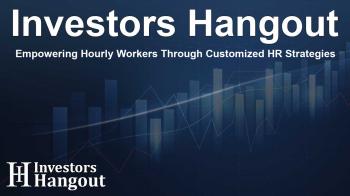Empowering Hourly Workers Through Customized HR Strategies

Transforming HR Programs for Hourly Employees
McLean & Company has recently unveiled research that highlights an essential four-step approach to assist HR leaders in creating and executing HR programs specifically designed for hourly workers. These employees represent a crucial yet frequently overlooked segment of the workforce. This insightful study delves into the operational hurdles and antiquated mindsets that have historically marginalized hourly employees, proving that investing in customized HR strategies can significantly enhance the entire employee lifecycle.
The Significance of Tailored HR Programs
Today, more than 60% of the U.S. workforce consists of hourly workers. It is a demographic that has largely been neglected in traditional HR practices. According to McLean & Company, HR leaders are now provided with a robust framework to support these essential workers, ensuring they are no longer sidelined but instead celebrated for their contributions. The resource titled Customize HR Programs for Hourly Workers offers a data-driven guide designed to tailor programs addressing the distinct needs of the hourly workforce.
Understanding the Core Challenges
As explained by Karen Mann, the senior vice president of HR Research and Advisory Services at McLean & Company, organizations often rush to attract hourly workers in response to high turnover rates. However, true retention and engagement begin with inclusivity, emphasizing the need for HR programs that genuinely reflect the frontline experience. Despite the critical role hourly employees play in various industries, ranging from manufacturing and healthcare to hospitality and retail, many still feel unsupported. A notable 41% of frontline employees report that their employers have made no efforts to improve workplace conditions in the past year.
Mindset Over Operations
Mann articulates that the fundamental issue lies not in operational challenges but rather in outdated mindsets. HR leaders are encouraged to confront conventional wisdom that suggests hourly programs are too daunting or not worth the investment. The research indicates a marked gap between the intentions of HR leaders and the actions taken to ensure hourly employees are included in engagement and development initiatives.
The Four-Step Process for Effective Implementation
McLean & Company's newly published blueprint delineates a four-step process for customizing HR programs throughout the employee lifecycle. This process begins with:
- Identifying the need for customization,
- Prioritizing impactful programs,
- Customizing selected HR initiatives, and
- Implementing the programs with clear communication and change plans.
When executed effectively, this strategy fosters increased inclusion, engagement, and retention, ultimately leading to substantial improvements in areas such as productivity, customer satisfaction, and cost efficiencies.
Engagement as a Continuous Journey
The insights from McLean & Company illuminate that engagement is attainable at every point of employment, provided that programs are thoughtfully designed to resonate with the daily experiences of hourly workers.
Connecting with McLean & Company
For media inquiries or to engage with McLean & Company’s experts for exclusive insights into employee engagement, HR priorities, and trends in talent management, interested parties can reach out to the Communications Manager, Katie Tame.
About McLean & Company
McLean & Company combines evidence-based research with practical tools and extensive HR expertise to empower organizations in meeting contemporary workforce challenges while preparing for the future. This global HR research advisory firm serves a wide range of member organizations, providing them access to a wealth of resources, thorough diagnostics, collaborative workshops, actionable plans, and advisory services for HR professionals at all levels.
Additionally, McLean & Company is a proud division of Info-Tech Research Group, dedicated to delivering unrestricted access to invaluable research across various domains including HR, IT, and software analytics.
Frequently Asked Questions
1. What is the focus of McLean & Company's recent research?
The research centers around creating effective HR programs tailored for hourly employees, addressing their unique needs and experiences.
2. How significant is the hourly workforce in the context of employment?
Hourly employees constitute over 60% of the U.S. workforce, making their engagement critical for organizational success.
3. What are the key steps in McLean & Company's four-step process?
1) Determine need for customization, 2) Prioritize impactful programs, 3) Customize HR initiatives, 4) Implement with clear communication.
4. Why is inclusivity important in HR programs?
Inclusivity leads to higher engagement, improved retention rates, and better alignment with the realities of hourly workers' experiences.
5. How can I connect with McLean & Company for more insights?
Media professionals can contact Communications Manager Katie Tame for exclusive insights and resources on HR and employee engagement topics.
About The Author
Contact Dominic Sanders privately here. Or send an email with ATTN: Dominic Sanders as the subject to contact@investorshangout.com.
About Investors Hangout
Investors Hangout is a leading online stock forum for financial discussion and learning, offering a wide range of free tools and resources. It draws in traders of all levels, who exchange market knowledge, investigate trading tactics, and keep an eye on industry developments in real time. Featuring financial articles, stock message boards, quotes, charts, company profiles, and live news updates. Through cooperative learning and a wealth of informational resources, it helps users from novices creating their first portfolios to experts honing their techniques. Join Investors Hangout today: https://investorshangout.com/
The content of this article is based on factual, publicly available information and does not represent legal, financial, or investment advice. Investors Hangout does not offer financial advice, and the author is not a licensed financial advisor. Consult a qualified advisor before making any financial or investment decisions based on this article. This article should not be considered advice to purchase, sell, or hold any securities or other investments. If any of the material provided here is inaccurate, please contact us for corrections.

